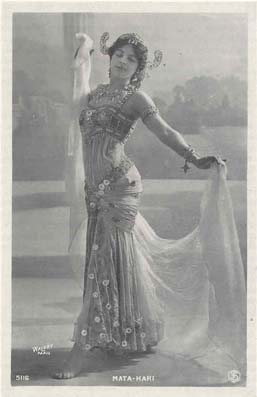1. MAC LEOD. C.p. pintado a mão. Fot. Walery, Paris (1905). Ed. S.I.P.
2. MATA-HARI C.p. pintado a mão e com enfeites em lantejoulas. Fot. Walery, Paris (1905). Ed. S.I.P.
3. MATA-HARI. C.p. pintado a mão e com enfeites em lantejoulas. Fot. Walery, Paris (1905). Ed. S.I.P.
4. MATA-HARI. C.p. pintado a mão. Fot. Walery, Paris (1905). Ed. S.I.P.
5. MATA-HARI. C.p. pintado a mão. Fot. Walery, Paris (1905). Ed. S.I.P.
6. MATA-HARI. C.p. pintado a mão. Fot Paul Boyer, Paris. Circa 1906. Ed.S.I.P.

3
MATA-HARI
Encarcerada
e submetida a julgamento em Paris por um tribunal militar, sob a acusação
de espionagem a favor da Alemanha, Mata-Hari foi condenada a morte sem
provas concretas e conduzida ao pelotão de fuzilamento em 15 de
outubro de 1917.
Nascida na Holanda em
1876, Marguerite Gertruida Zelle divorciou-se aos 26 anos de idade de
um oficial das Indias Orientais Holandesas. Astuciosa, ex-senhora Mac
Leod passou, então, a praticar danças rituais aprendidas
em Java durante sua estada e seu casamento infeliz. O sucesso de suas
primeiras apresentações em Paris em 1905, como Madame Mac
Leod propagou suas vagas e fantasiosas origens orientais. Em seguida,
surgiu o nome Mata-Hari, uma legenda perfeita para a sagrada dançarina
do Oriente, que brilharia na capital francesa e nos principais teatros
de variedades europeus, como o próprio significado do pseudonimo:
o Sol.
Exótica e enigmática,
Mata-Hari fez de si mesma uma propaganda ininterrupta, capaz de esgotar
as blheterias e arrebatar as platéias da Europa. Irresistível,
conquistou as atenções e os favores de oficiais franceses
e alemães influentes, no período conturbado da Primeira
Guerra Mundial. Sua "queda" por fardas graduas ou seu real interesse
em obter importantes informações para a Alemanha, levaram-na
ao processo que apagaria para sempre sua estrela luminosa.
MATA-HARI
Jailed
and subjected to trial in Paris by a military court, under the accusation
of being a German spy, Mata Hari was condemned to death without formal
proof, and taken to be executed by a firing squad on October 15, 1917.
Born Marguerite Gertruida
Zelle, in Holland, she at 26, divorced her husband, and officer belonging
to the Dutch Oriental Indies. An artful woman, the ex-Mrs. Mac Leod then
began to practise riual dances that were learned during her stay in Java
at the time of her unhappy marriage. The success of her first performances
in Paris in 1905, s Madame Mac Leod, propagated her vague and fanciful
Oriental origins. The Mata Hari followed, a perfect legend for the sacred
Oriental dancer who would shine in the French capital and in most variety
theatres in Europe, as the meaning of her stage name implied: The Sun.
Exotic and enigmatic,
Mata Hari advertised herself incessantly and was able to hold the stage
for sold out audiences throughout Europe. An irresisible woman, she was
able to conquer the attention and favors of influential French and German
officers during the troubled times of the First World War. Her "inclination"
towards high standing uniforms, or her real interest in obtaining important
information for Germany, led her towards the trial that would forever
extinguish her shining star.